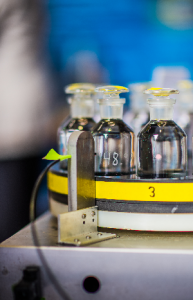AutoBOD-1 Real-Time Wastewater Biological Oxygen Demand Sensor
Inventors: Benjamin Van Mooy and Richard G. Keil
Publication No. US9188512B2

Overview: Biological Oxygen Demand (BOD) is the measurement of oxygen consumed by microorganisms within wastewater samples in the absence of light. BOD measurement is an important indicator of the biological load of wastewater effluent and has been mandated by the EPA to be within prescribed specifications for all wastewater effluent. Over 16,000 wastewater treatment facilities exist in the US. Each is required to monitor effluent BOD on a monthly basis, requiring sampling with a five-day incubation period. Existing methods do not provide real-time information on the actual health of the biomass in the water column and cannot be used to inform instantaneous adjustment of culture conditions; this causes many facilities to turn to surrogate tests for process control.
Technology: AutoBOD-1, a carousel benchtop commercial prototype designed to replace the current EPA mandated 5-day BOD test, has been developed and is currently in proof of concept studies to validate the underlying technology and garner EPA and customer acceptance. AutoBOD-1 brings reagent-free, real-time BOD measurement and process control capability to the wastewater treatment arena. All AutoBOD-1 instruments feature micro-processor-based control and data processing to measure oxygen consumption on undiluted wastewater samples. Oxygen consumption is tracked in light and air-tight chambers using Optode technology. No wet chemistry is involved and the device may be operated and maintained by personnel with minimal training. AutoBOD 1, for benchtop use, has a carousel format and is capable of ongoing oxygen consumption measurement for twelve individual wastewater samples. Samples are collected manually in standard 200 ml wastewater sampling bottles. The second-generation technology, AutoBOD-2, is an inline, remotely operated, flow-through system with the capability for multiple unit deployments within a single facility.
CONTACT
To learn more about this opportunity please contact:
The Office for Technology Transfer
- Email: techtransfer@whoi.edu
- Phone: (508) 289-3447


